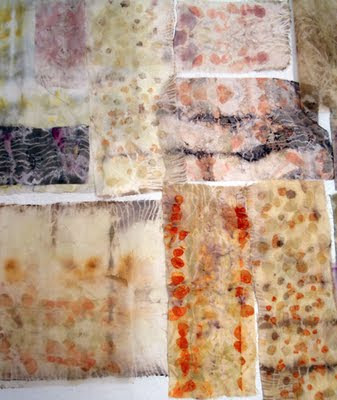Darcy Ritzau from California made this piece. It's wool challis with some incredible eucalyptus.
Ellen Flachmann of St. Louis did this group of samplers.
Suzy Farren of Missouri removes onion skins from fabric that she eco printed. Thanks to Theresa Goetz for supplying the photo.
These 4 samples were made by Theresa Goetz of Missouri
Carolyn Lesser of St. Louis made these samplers.
Judy Newland of Arizona did some ice flower dyeing with hollyhocks to create the lavender strips before she came to the workshop.
These samples were already turned into a mini patchwork by the last day. Made by Peggy Cox of Pennsylvania.
I've heard from one person that she's been bundling and brewing up eco prints every day since the workshop. Sorry to say, I haven't been able to indulge myself yet but I do have the copper cauldron and am itching to try out some larger fabric.
If you are visiting for the first time, scroll down to see parts 1, 2 and 3 about the India Flint workshop. I had the time of my life and learned so much. Now I'm waiting delivery of Second Skin, India's new book hot off the presses.














thanks thanks for sharing all the results...you were a talentful groop....
ReplyDeleteThank you for sharing this amazing group of woman's creations. India is one talented woman to enable woman to produce such amazing work. Yu all looked as if you had a whale of a time.x lynda
ReplyDeleteYes same here, what a treat to see the results of Indias workshop, thanks so much for the peep into what went on.
ReplyDeleteHi Pat - Thanks for sharing all the amazing results you all achieved in the workshop. I'm having fun exploring this technique too - one question I have: Have you had any issues with the color being "fugitive", or what process have you found works best for "setting" the color in the fabric? I've heat set it and let the fabrics sit for a long time before washing, but hesitant to wash as I'm hoping not to lose too much of the color.
ReplyDeleteThank you all for your comments.
ReplyDeleteAynhanne, I've not had enough experience with this particular process (India's eco print technique) to know how the colors will react when washed. These samples were photographed after just a water rinse. My own samples were treated the same. I will tell you virtually no color rinsed out of the fabric after the bundling technique which I take as a good sign. The iron and copper serve as mordants. Cooking the imprint into the fabric must do the trick. Anything with eucalyptus is permanent according to India.
Keep in touch, as soon as I'm finished with my present mountain of show work, I plan on doing some bundling of my own using India's technique.
I often lay aside pieces that I've used berries on while rusting to let the fabric cure so to speak. Keep in mind that any natural color will fade under strong light (rust and walnut color seeming to be the exception). I always say I'm going to conduct some fade tests--but I'm such a procrastinator! The tea I use (in my rust work)and the fermented juices contain tannins and the iron all act as mordants to help preserve the color of berries and such.
Good luck with your dyeing.
Gracias ¨Pat por la generosidad de compartir las experiencias con India ¡¡¡¡¡¡
ReplyDeleteDesde Chile,Susana
Thank you Susana for stopping by. India's workshop was over a year ago and I still have not done any serious eco printing on my own yet! But I just acquired a firepit where I plan to set up an eco printing cooking station near my outdoor studio. Looking forward to finally getting a start with color.
Delete